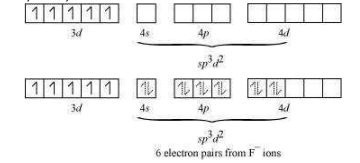9.15 Discuss the nature of bonding in the following coordination entities on the basis of valence bond theory:
(i) [Fe(CN)6]4– (ii) [FeF6]3–
(iii) [Co(C2O4)3]3– (iv) [CoF6]3–
(i)
In the above coordination complex, iron exists in the +II oxidation state.
: Electronic configuration is as follows:
Fe2+ = 3d6
As is a strong field ligand, it causes the pairing of the unpaired 3d electrons.
Since there are six ligands around the central metal ion, the most feasible hybridization is
6 electron pairs from CN- ions occupy the six hybrid
Then,
Hence, the geometry of the complex is octahedral and the complex is diamagnetic (as there are no unpaired electrons).
(ii)
In this complex, the oxidation state of Fe is +3. The orbital diagram of Fe3+ is as follows:
Fe3+ = 3d5 ;
There are 6F- ions. Thus, it will undergo or hybridization. As F- is a weak field ligand, it does not cause the pairing of the electrons in the 3d orbital. Hence, the most feasible hybridization is
hybridized orbitals of Fe are:
Hence, the geometry of the complex is found to be octahedral.
(iii) [Co(C2O4)3]3–
Cobalt exists in the +3 oxidation state in the given complex.
The orbital diagram of Co3+ is as follows:
Co3+ = 3d6 ;
Oxalate is a weak field ligand. Therefore, it cannot cause the pairing of the 3d orbital electrons. Hence, the hybridization is sp3d2
Hence, the geometry of the complex is found to be octahedral.
(iv) [CoF6]3–
Cobalt exists in the +3 oxidation state. The orbital diagram of Co3+ is as follows:
Co3+ = 3d3;


© 2025 GoodEd Technologies Pvt. Ltd.



